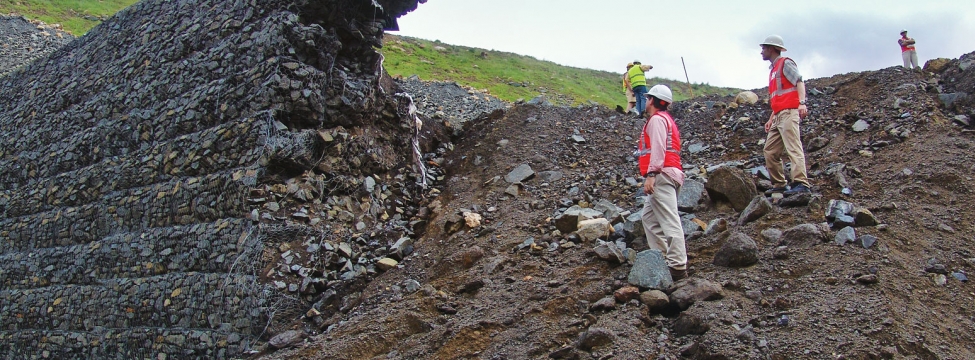To serve you better, our new website displays information specific to your location.
Please visit the site and bookmark it for future use.
Slope stability – fundamental concepts
Despite the widespread availability of software programs using sophisticated numerical methods, the physical principles of slope engineering should not be forgotten. Simple, well considered engineering judgment based on fundamental principles, which identify all potential mechanisms of failure and account for the stability of each mechanism in the design, are critical.
Recently, SRK was involved in reviewing the design of a 15m high gabion structure that collapsed. The gabion had supported a crusher terrace for the mine. The potential failure mechanisms included toppling/rotation, sliding, deep seated slip circle, bearing and wedge failure. The designers had used software that only considered horizontal sliding, and circular slip failure. The wall was built on rock and the lower section was doweled, making slip failure unlikely, while bearing failure and horizontal sliding were within the bounds of acceptability, but the wall still collapsed. The reason SRK identified was that the software interpreted the gabion structure as an infinitely strong ‘monolith’ which did not allow internal diagonal failure. But the planar wedge failure mechanism was “plane” to see on site. This is a clear example of using software that was inappropriate for the task. Simple hand calculations identified the potential flaw immediately. Subsequent numerical analyses using Slide and Phase2 confirmed the failure mechanism.
Whenever slope stability is being assessed, the concept of demand versus capacity of the structure must be continually considered. Demand is the loading action applied by gravity through the mass of the material being retained and includes the water, dynamic and seismic effects. Capacity is the internal strength of the material or structure to resist those loads. Both the concept of Factor of Safety and Probability of Failure are derived directly from these terms. The factor of safety is the simple ratio between capacity and demand calculated for defined values. Since the 17th century, engineers have calculated the strength (capacity) of material with given or defined properties, and assessed the load (demand) imposed, to make sure the capacity exceeded demand so the structure was deemed acceptable.
The probability of failure is a far more powerful concept based on the difference between the fundamental statistical variability of capacity and demand that strives to answer the question: what is the probability that demand will exceed capacity from all possible values of the intrinsic variables?
Closely allied is the concept of risk. Increasingly, clients want to know the risk of their structure failing, including the concepts of voluntary and involuntary risk. Involuntary risk applies to civil structures used by the public, while voluntary risk applies to mining operations. Risk and probability techniques investigate and assess these consequences.
Employing fundamental concepts of probability of failure, factor of safety and risk are obligatory in design. SRK personnel are proficient in all these concepts and regularly bring them to bear on our projects.
Graham Howell: ghowell@srk.co.za
|
You can download a PDF of the entire |
PDF
A4 |
PDF
Letter |
|
|
|
Our newsletters focus on specific areas of interest to earth resource professionals and clients. Each is available as an Adobe Acrobat PDF file. If you don't already have Adobe's PDF reader, you can download it free.
![]()


